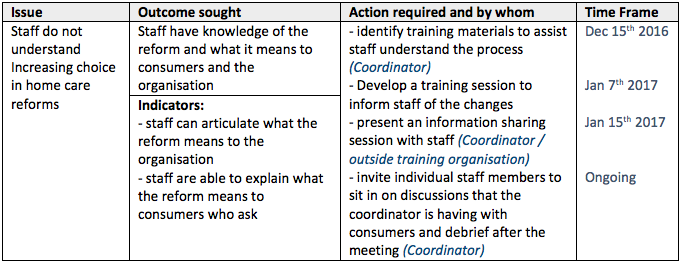Last week we talked about the changes that are rolling out in the aged and disability sectors and how you can future-proof your organisation. For some organisations, there may be a number of improvements or activities that need to be completed in time for the reforms that will be implemented on 27th February 2017.
To help plan for these changes, think about the old joke ‘how do you eat an elephant?’ One bite at a time. By breaking a large target down into bite-size chunks, things become easier to work through both physically and mentally.
Why 90 Days?
Although you can also develop 30 and 60-day plans, many people see 90-day blocks of time as the right amount of time to achieve something of worth. Just think of the three-month probationary periods used in workplaces. Organisations know that it takes around 90 days to bring a new employee up to speed with internal policies and procedures and learn how to do their job properly. It is also not too long a time period in our mind, so we are less likely to lose concentration. Ninety-day plans can be used for just about any goal, whether that be losing weight or planning a product launch.
For example, here at CDCS we have just launched our new podcast for people working, or interested, in the community care sector – the ‘Care Directions’ podcast (you can find us over on iTunes or listen here on the website). Although starting a podcast was something we had been thinking about for a couple of years, the sheer size of the project – what I had to do physically combined with the lack of knowledge in the area – held me back from doing anything at all.
A couple of months ago however, we made the decision that the podcast launch would be the 15th November 2016, and we did it! On Tuesday, the podcast went live on iTunes.
Was it easy? No.
Were there times when I thought I couldn’t do it? Yes.
Did I think about giving up and getting someone else to do it for us? Often.
So how did we manage to meet our deadline?
A written, 90-day plan for the project.
With a defined end date and knowing the end goal, I broke down each step along the way: cover art, recording, editing, naming the show, hosting and uploading to iTunes for approval. Whew! There were a lot of things to learn and put in place, but our 90-day plan made it easier. I simply took each step, broke it down further into subtasks and did one thing each day.
Now, here at CDCS, we use a free online program called ASANA to help us with our planning. This program allows us to set dates and subtasks and we can share projects between our team members. But you don’t need to use on online planner, you can stick to the tried and true method of paper, pen and calendar.
Remember, it can't just be in your head, it needs to be written down. So let’s get started on setting up a 90-day plan.
Seven Steps to Setting up your 90-Day Plan
Step 1. Identify your Goal (3 minutes)
It might be something to do with your work, such as being ready for the introduction of the reforms in your organisation, or it could be a personal goal of reaching a target weight or dress size. Whatever it is, most of us have something that we want to work towards.
Once you have identified a gap or area to improve, you want to start acting on it. However, your day is busy and important-but-not-urgent things get pushed aside. This is where the 90-day plan comes into play.
Step 2. Set the Date (2 minutes)
Grab your calendar or diary or open your electronic planner. Count out 90 days from your planned start date – that could be today or you might be doing some forward planning for a future project.
Step 3. Review your Goal and break it down into its different elements (5 minutes)
For example, if you want to lose 15 kilograms of weight, you might work out that you need to lose approximately 1 kilogram each week.
Step 4. Work out what you need to do each day to reach your weekly goal (5 minutes)
What do you need to do to lose that 1 kilogram each week? Perhaps it is to modify your activity level or diet.
Step 5. Write down your daily action plan (10 minutes)
Once you know what needs to be done each day, write your daily action plan down. Using our example above, you could write out your goal for activities for each day and your dietary plan for the day.
Congratulations! That's your basic 90-Day Plan completed, a massive step towards achieving your goal. The next two steps will help you refine your plan and keep you travelling in the right direction.
Step 6. Review your plans daily
At the start of each day, you should review your daily plans or mini-goals. Again, taking our example, you would look at what activity you have planned – perhaps a half-hour walk in the morning and your day’s menu plan.
Step 7. Review and celebrate your achievements
At the end of each day, week and month you should review what you have achieved. Although you may not achieve a target by a specific day, by looking at the plan weekly and monthly, you should be able to see how you are tracking.
How does this work in the workplace?
If we apply this method to the workplace, your plan may become a little more detailed. The 90-day action plan that we use when working with coordinators and their managers includes: looking at the issues that have been identified, what outcome the coordinator seeks, what the success indicators might look like, actions that are required and by whom, plus setting out expected time frames.
For example, if you were a coordinator and realised that your front-line staff were not aware of the ‘Increasing Choices at Home’ reform process or what these changes mean to both consumers and the service, you might want to think about setting up a 90-day plan to remedy this.
Your plan might look something like this:

This plan is still high level, you would need to break it down further to weekly and daily activities to help reach your targets within the timeframes you have set. This is where a daily diary comes in handy. You might devote some time each week to sourcing the right training and information, you just want to have made your decision and have the training materials by the 15th December. This allows you to move onto the next phase – developing the training session.
Remember – the more you can break something down, the more chance you have of meeting your goal.
Each time you complete a mini-goal your mind does a little happy dance!
The endorphins that are released into your brain when this happens gives you satisfaction and helps to keep you focused. So next time you need to reach a goal, try using a 90-Day Plan. You may be surprised at what you can achieve in three months!
Don’t forget to check out our podcast the ‘Care Directions' podcast. Search for ‘Care Directions' in the iTunes store, via the Stitcher App or listen here on the website.
Want to know more about getting ready for the Increasing Choice in Home Care Reforms? Read last week’s blog post.
- Aged Care Packages – what's in the box? - February 16, 2024
- 11 Ways to Make Your Progress Notes Better - September 22, 2023
- Vulnerable Clients – Who are they? - July 14, 2023




